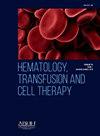¹⁸f-fdg和¹⁸f-psma在肺癌中的Pet / ct检测:腺癌和鳞状细胞癌的差异
IF 1.6
Q3 HEMATOLOGY
引用次数: 0
摘要
引言/理由肺癌仍然是世界范围内死亡的主要原因。使用¹⁸F-FDG的PET/CT通过评估肿瘤细胞中糖酵解代谢的增加,被广泛用于肺癌的检测、分期和监测。前列腺特异性膜抗原(PSMA)虽然主要是前列腺癌的标志物,但也与肿瘤新生血管生成有关,并已在包括肺癌在内的各种恶性肿瘤中显示出摄取,表明其潜在的治疗应用。目的比较¹⁸F-FDG和¹⁸F-PSMA在原发性和转移性肺癌病变中的摄取情况,分析腺癌和鳞状细胞癌(SCC)亚型之间的差异。材料与方法14例确诊肺癌患者(男9名,女5名),年龄55-82岁(腺癌10例,鳞状细胞癌4例),分别在静脉注射0.1 mCi/kg¹⁸F-FDG后60分钟和静脉注射0.1 mCi/kg¹⁸F-PSMA后90分钟接受PET/CT扫描。影像由两名核医学医师和一名放射科医师评估。测量了两种示踪剂在原发肿瘤、局部淋巴结和远处转移性病变中的最大标准化摄取值(SUVmax)。在两种示踪剂中,通过背景以上的SUVmax摄取和视觉分析来确定病变。结果共分析288例病变(腺癌247例,鳞状细胞癌41例)。在腺癌中,¹⁸F-PSMA检测到215个病变,而¹⁸F-FDG检测到237个病变。¹⁸F-PSMA只检测到9个病变,而¹⁸F-FDG只检测到32个病变。45个病变显示较高的¹⁸F-PSMA摄取,174个病变显示主要的¹⁸F-FDG摄取。¹⁸F-FDG的中位SUVmax为6.5(范围:1.8-24.5),而¹⁸F-PSMA的中位SUVmax为4.0(范围:0.7-24.8)。在SCC中,¹⁸F-PSMA检测到36个病变,而¹⁸F-FDG检测到41个病变。没有病变显示主要的¹⁸F-PSMA摄取,并且¹⁸F-FDG的SUVmax值更高(中位数:8.8;范围:1.3-36.6)与¹⁸F-PSMA(中位数:2.5;范围:0.9 - -10.4)。我们发现,在两种放射性示踪剂均摄入的SCC和腺癌亚型病变中,¹⁸F-PSMA的SUV值具有统计学差异(Mann-Whitney U检验,p值<;0.0001)。此外,在两种组织学亚型中,我们还观察到¹⁸F-FDG和¹⁸F-PSMA suv的正相关性,其中SCC的正相关性很强(r = 0.0,8140,p值<;0.0001),中度为腺癌(r = 0.4278,p值<;0.0001)。结论:使用¹⁸F-FDG和¹⁸F-PSMA PET/CT,这些发现突出了腺癌和鳞状细胞癌之间不同的摄取模式。SCC表现出明显更高的¹⁸F-FDG摄取,而最小的¹⁸F-PSMA摄取,表明¹⁸F-PSMA在该亚型中的作用有限。相比之下,腺癌在大多数病变中表现出更高的¹⁸F-FDG摄取,但一小部分病变表现出显著的¹⁸F-PSMA摄取,这表明新生血管生成与糖酵解代谢之间存在潜在联系。这些结果支持了¹⁸F-PSMA在腺癌评估中的补充作用,特别是在PSMA高表达的病例中。需要进一步的研究来确定其对个性化治疗策略和治疗应用的临床影响。本文章由计算机程序翻译,如有差异,请以英文原文为准。
PET/CT WITH ¹⁸F-FDG AND ¹⁸F-PSMA IN LUNG CANCER: DIFFERENCES BETWEEN ADENOCARCINOMA AND SQUAMOUS CELL CARCINOMA
Introduction/Justification
Lung cancer remains a leading cause of mortality worldwide. PET/CT with ¹⁸F-FDG is widely used for detecting, staging, and monitoring lung cancer by assessing increased glycolytic metabolism in tumor cells. Prostate-specific membrane antigen (PSMA), although primarily a marker for prostate cancer, is also associated with tumor neoangiogenesis and has shown uptake in various malignancies, including lung cancer, suggesting potential theranostic applications.
Objectives
This study aims to compare the uptake of ¹⁸F-FDG and ¹⁸F-PSMA in primary and metastatic lung cancer lesions, analyzing differences between adenocarcinoma and squamous cell carcinoma (SCC) subtypes.
Materials and Methods
Fourteen patients (9 men and 5 women), aged 55–82 years and diagnosed with lung cancer (10 adenocarcinoma, 4 SCC), underwent PET/CT scans on two separate days: 60 minutes after intravenous administration of 0.1 mCi/kg of ¹⁸F-FDG and 90 minutes after intravenous administration of 0.1 mCi/kg of ¹⁸F-PSMA. Images were assessed by two nuclear medicine physicians and one radiologist. The maximum standardized uptake value (SUVmax) was measured for both tracers in primary tumors, regional lymph nodes, and distant metastatic lesions. The lesions were defined in both tracers by an SUVmax uptake above the background and visual analysis.
Results
A total of 288 lesions were analyzed (247 adenocarcinoma, 41 SCC). In adenocarcinoma, ¹⁸F-PSMA identified 215 lesions, compared to 237 detected by ¹⁸F-FDG. Nine lesions were exclusive to ¹⁸F-PSMA, while 32 were detected only by ¹⁸F-FDG. Forty-five lesions showed higher ¹⁸F-PSMA uptake, while 174 exhibited predominant ¹⁸F-FDG uptake. The median SUVmax for ¹⁸F-FDG was 6.5 (range: 1.8–24.5), compared to 4.0 (range: 0.7–24.8) for ¹⁸F-PSMA. In SCC, ¹⁸F-PSMA identified 36 lesions, while ¹⁸F-FDG detected 41. No lesions showed predominant ¹⁸F-PSMA uptake, and SUVmax values were higher for ¹⁸F-FDG (median: 8.8; range: 1.3–36.6) compared to ¹⁸F-PSMA (median: 2.5; range: 0.9–10.4).We found that SUV values for ¹⁸F-PSMA are statistically different between SCC and adenocarcinoma subtypes in the lesions that showed uptake of both radiotracers (Mann-Whitney U test, p-value < 0.0001). Also, a positive correlation was observed for ¹⁸F-FDG and ¹⁸F-PSMA SUVs in both histological subtypes, being strong for SCC (r = 0.0,8140, p-value < 0.0001) and moderate for adenocarcinoma (r = 0.4278, p-value < 0.0001).
Conclusion
These findings highlight distinct uptake patterns between adenocarcinoma and SCC using ¹⁸F-FDG and ¹⁸F-PSMA PET/CT. SCC demonstrated markedly higher ¹⁸F-FDG uptake with minimal ¹⁸F-PSMA uptake, indicating limited utility of ¹⁸F-PSMA in this subtype. In contrast, adenocarcinoma showed higher ¹⁸F-FDG uptake in most lesions, but a subset exhibited significant ¹⁸F-PSMA uptake, suggesting a potential link between neoangiogenesis and glycolytic metabolism. These results support a complementary role for ¹⁸F-PSMA in adenocarcinoma evaluation, particularly in cases with high PSMA expression. Further studies are needed to determine its clinical impact on personalized treatment strategies and theranostic applications.
求助全文
通过发布文献求助,成功后即可免费获取论文全文。
去求助
来源期刊

Hematology, Transfusion and Cell Therapy
Multiple-
CiteScore
2.40
自引率
4.80%
发文量
1419
审稿时长
30 weeks
 求助内容:
求助内容: 应助结果提醒方式:
应助结果提醒方式:


